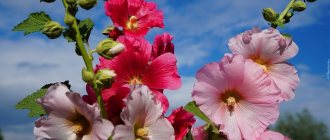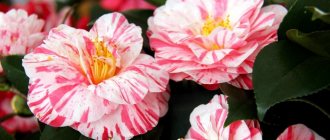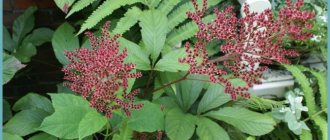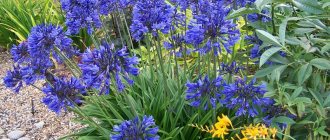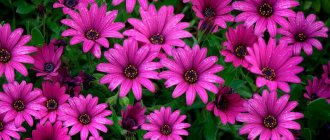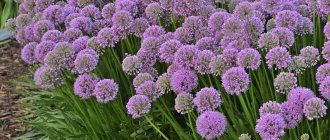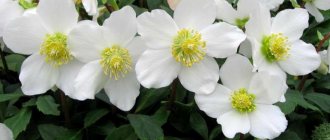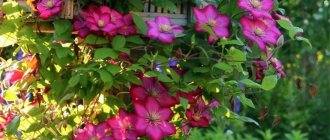Globularia Globularia is a genus of European or Asian origin from the plantain family, which includes 28 species of herbaceous plants ranging in height from 15 to 65 cm with an erect or creeping stem. The plant got its name from its almost spherical inflorescence with many small flowers. People often call them ballers. Several species are classified as relict species and are especially protected.
The globe ball pads grow and fill the empty spaces, becoming more and more beautiful every year. They look most attractive in the cracks between stones. They can hide voids after the death of early flowering species in spring. The clumps of the bulbous plants are not dense - the bulbous leaves easily find their way between them.
Content
- General information
- Varieties and types
- Globularia planting and care in open ground
- Watering globularia
- Soil for globularia
- Globularia transplant
- Fertilizer for globularia
- Globularia bloom
- Trimming globularia
- Preparing globularia for winter
- Globularia growing from seeds
- Propagation of globularia by cuttings
- Globularia propagation by dividing the bush
- Diseases and pests
- Conclusion
Care
It does not require special maintenance conditions; to obtain rich, dense flowering, it is enough to periodically loosen the soil, remove weeds, and water the soil as it dries. With excessive watering, globularia begins to grow, foliage begins to grow abundantly, flowers appear less frequently, and with stagnant water, the roots begin to rot. Once a month you should feed the flower with fertilizers. Only the hair-flowering one needs replanting every 4 years, since in the center the old bushes die and dry out. For other types of Sharovnitsa, transplantation is possible after 8 – 10 years.
General information
The plant is called the globe flower because it has sphere-shaped inflorescences consisting of small flowers. Some varieties of globularia are relict and are protected by environmental organizations.
As the bushes grow, they fill up the free space, becoming more attractive with each season. They look best on alpine slides made of stones, growing through cracks.
They can also be used to hide empty areas that form after early plants have flowered. In addition, the ballerina is unpretentious in care and growing it will not be difficult even for a novice gardener.
Most popular varieties
Photo 1. Globularia hairy-flowered
Globularia hairy-flowered (photo 1) is distinguished by tall flowering shoots (up to 30 cm), with single lilac-blue flowers similar in shape to dandelions. The leaves are narrow, with teeth along the edges. Flowering occurs in June.
Globularia dwarf – low-growing (up to 10 cm). It blooms in May with light blue loose spherical flowers.
Photo 2. Heart-leaved globularia
Globularia cordata (photo 2) is distinguished by hemispherical flowers of violet-blue tones. Flowering begins at the end of May and lasts about 4 weeks. It forms dense thickets, the height of which after removing the flowering shoots is about 7 cm. Varieties with white flowers have been bred.
Photo 3. Globularia punctata
Globularia punctata (photo 3) forms rosettes. The height of flowering shoots is about 25 cm. It blooms in early summer with blue, slightly flattened flowers. In snowless winters it can freeze without shelter.
Growing and care
Sharovnitsa prefer sunny places. The nutritional value of the soil is not important, but breathability is required. Before planting, it is advisable to add a small amount of dolomite flour to provide a slightly alkaline environment.
They cannot tolerate stagnant water. Drought resistance is high, watering is practically not required. Most plants overwinter well without shelter.
If the seeds are not needed, then after flowering the flower stalks must be removed. Some species require replanting every 4 years due to the death of the central part, others can grow up to 10 years without losing their decorative appearance.
Reproduction
All Sharovniks are propagated by seeds, separating rosettes (dividing bushes), and cuttings. When propagated by seed, young plants usually bloom in the second year.
Use in landscape design
Globularia are decorative almost all year round, since many species do not lose foliage during warm winters. These are excellent plants for alpine hills, sunny rockeries and rocky slopes. In a solitary planting, the common mushroom is lost against the background of other plants, so only group plantings in the form of clearings or borders are used.
Low-growing species can be used in monoculture to create green carpets covered with flowers for a month. Medium-sized ones look good in ridges and in the foreground of flower beds. They are suitable as partners for brightly flowering plants, such as phlox or roses.
Varieties and types
Speckled Sharovnitsa is a herbaceous perennial, reaching a height of up to 30 centimeters, with medium, entire outer, ovate, lanceolate leaf blades with a rounded top, dark green in color. The inflorescences are spherical and pale blue. The flowering time of the crop begins in May and ends in July.
Sharovnitsa Spot - the culture reaches a height of up to 24 centimeters. It has rich, green, elliptical-shaped leaves. The inflorescences have a hemispherical shape and an ultramarine hue. The flowering time of globularia is mid-summer.
Globularia cordatefolia is a low, compact crop, reaching up to 10 centimeters in height. The leaf blades are medium-sized, dark green, elliptical in shape. The inflorescences are spherical and can be purple, pink and white. Globularia blooms from June to July.
Creeping Sharovnitsa is a compact plant variety that is a luxurious shrub with medium, elliptical dark green leaf blades and dark blue spherical inflorescences. The bloomer's curtain is dense, reaching a height of up to 5 centimeters. It is frost and drought resistant. Globularia loves the sun very much. Flowering time occurs in mid-summer.
Globularia Volosotsvetkovaya - the plant is listed in the Red Book and is a relict. Sharovnitsa has lower oval and upper straight leaf plates of dark green color. The inflorescences are basket-shaped, medium in size and pale blue in color.
The most attractive types of globularia
Almost all globularia growing in the Caucasus, Mediterranean, Crimea and the Alps belong to relict and protected species.
- GLOBULARIA BISNAGARICA - One of the choicest of this unusual group of flowers, this variety has unusually tall stems (30-40 cm), arching slightly at the top, with truly exceptional, large, bright blue, spiky, powdery flowers. Even the foliage is attractive, consisting of thick, leathery, bladed leaves buried deep underneath.
- GLOBULARIA NUDICAULIS (holostem) - A slow-growing plant, it opens its surprisingly deep cobalt blue flowers in early spring, which appear on short stems from a compact rosette of leathery oval leaves. It grows best in a well-drained rocky garden with infrequent summer rains, when other more vigorous plants will not encroach on it.
- PUNCTATA (pointed) is a winter-hardy, evergreen perennial native to mountain meadows and rock crevices in central Europe, with upright stems bearing rich blue globose flowers above glossy leaves in a dense basal rosette. It is very easy to cultivate in any rich, well-drained soil in a sunny location.
- REPENS (dwarf or creeper) - Nearly leafless lavender-blue downy flowers bloom on clumps of dark green, glossy foliage. The leaves are glossy, spoon-shaped, and grow outward to form dense clumps. Best suited for sandy, well-drained soils, such as rock gardens, scree, alpine hills or depressions.
- TRICOSANTHA (hair-flowered) - Bright blue, lush flowers open in early summer on short stems above thick, shiny, evergreen leaves that grow to form an evergreen carpet. Native to the eastern Mediterranean and Balkan Peninsula, which are dry areas, so are best planted in well-drained soil or in rock gardens.
- VALENTINA - Native to the Spanish Pyrenees, this compact evergreen perennial has stiff, spreading, spoon- or lanceolate, gray-green leaves and straight, leafy stems with attractive, bushy, purple or blue flower heads. One of the larger and more attractive species, prefers sandy, well-drained soils.
- CORDIFOLIA (heart-leaved) is a low-growing species that forms a dense evergreen ground cover. In mid-spring, small leaf-shaped petals are spiked with spheres of fluffy steel-blue flowers. Grows moderately quickly in well-drained areas. Prefers full sun. Great for rock gardens. Cold-resistant, drought-adapted
- BLUE EYES - the bluest of all globularia. This species is quite rare. The plant produces low, evergreen, dense foliage that is level with the ground in mid-spring. Tall peduncles, 40 cm, end in foamy cobalt blue multifaceted balls of flowers. Prefers full sun and well-drained soil. Over time, the bush forms a dense, small-scale soil cover. Great in rock gardens, on slopes or in containers.
- INCANESCENS (grayish) - a rare precious species ideal for rock gardens. It has round, dark green leaves and, as the common name suggests, spherical blue and white flower heads. It grows very densely, ideal for fairy gardening.
- GLOBULARIA SALICINA (willow) - The bloom festival begins in late winter, continuing the show through spring with fluffy globular lavender-colored flowers. They hug the tips of the stem, covered with numerous oval leaves. Endemic to the country of very steep plants, the Canary Islands, where it is found in rocky, open areas. Loves rich, well-drained soil and a sunny position where it will grow into a woody shrub measuring 50 x 70 cm.
Globularia planting and care in open ground
Globularia is an unpretentious plant that prefers calcareous, loose, permeable soil. It is better to choose a sunny place for planting, as shade has a bad effect on the crop. Most often, the wildflower is sown with seeds, after which the germinated seedlings are used, having prepared the bed and soil mixture in advance.
The substrate should be light and waterproof, and when planting seedlings, drainage should be created from fine expanded clay or coarse river sand added to the main soil mixture. A fairly large distance should be left between the seedlings, because due to the creeping shoots, the crop grows quickly and occupies a significant area, forming unusual decorative pillows.
The plant is quite frost-resistant and can go without watering for a long time, however, it does not like waterlogging of the soil, as this causes rotting of the root system.
If you want to decorate an alpine hill or garden bed with an unusual ornamental crop, we advise you to pay attention to globularia. It is not only unpretentious, but also looks very advantageous in combination with other garden flowers, so by planting it on your site, you will definitely be a winner.
Bacopa is also a member of the Plantain family. It is grown when planted and cared for in open ground, and some species can also be kept as aquarium plants. You can find all the necessary recommendations for growing and caring for this plant in this article.
Use in landscape design
A distinctive feature of the bloomer is that it remains decorative throughout the year; evergreen perennials do not shed their leaves, but retain a fresh green appearance, which flower growers actively use when decorating alpine hills, rockeries, borders, and rocky slopes. Globularia is lost; when planted alone against the background of other garden flowers, in order to reveal all the beauty of the plant, they are planted in single flower beds, paths and entire clearings. It also goes well with rose bushes, phlox, cereals, geraniums, sedum, sedum, chamomile, and yarrow.
Soil for globularia
The most important condition is the looseness and nutritional value of the soil for the plant. To prepare a substrate for planting a crop, you should mix garden soil with humus and coarse river sand as drainage. In order to create the pH necessary for the culture, a little dolomite flour is added to the soil.
When the globularia takes root, it is necessary to loosen the top layer of soil from time to time and remove weeds.
Annual plants
A sea of blue flowers planted in one flowerbed gives a feeling of depth and joy. To make them represent the picture of sea waves, blue flowers are selected of different heights, with different configurations of buds and flowering periods.
The opportunity to create a feeling of sea space will be provided by annual blue plantings. Annual crops go through all life stages in one season. They develop, are decorated with inflorescences, then produce seeds and disappear.
Designers love annuals for their richness of varieties, which allow them to create unique flower pictures.
cornflower
These unpretentious wildflowers can often be seen in a flowerbed, among other fellows. It blooms for a very long time. Starts in July and ends in September. Prefers dry places illuminated by the sun. When July comes, the bush puts on a “veil” of many delicate buds, which are painted in blue tones.
There are flowers that look like cornflowers. This is Nigella, a fast growing plant with dark blue or blue flowers. The shape of simple, often double flowers resembles cornflower blue stars.
It turns out that there is even more than one species of flowering plants similar to cornflower. These are chicory, stokesia, leuzea, thistle. Chicory is grown as a medicinal plant, and other species are grown to decorate garden plots.
Nemophila American forget-me-not
A plant with charming blue bell-like flowers spreads in a wide carpet, filling all the free areas in the country house. The beautiful flower pleases with its blue expanse for a long time.
Nemophila is moisture-loving, shade-tolerant, prefers loose, non-alkaline soils. In addition to blue ones, you can find dark purple specimens. Sometimes their shade is so dark that the flowers appear black.
Heliotrope
Heliotrope has the appearance of a low-growing shrub with a branched stem
Small blue flowers attract attention with their heavenly beauty and pleasant aroma
The buds grow so densely that they resemble a blue cascade. It begins to bloom in June and continues until frost. Cut inflorescences, dried in the shade, can be added to winter bouquets.
Nigella damascene
The annual plant can be sown in open ground with seeds as early as April. After some time, bushes with branched stems 50-60 cm high and carved leaves will appear. Double flowers, up to 4 cm in diameter, will bloom June-July.
morning glory
This flower can climb on any support with a blue path. The climbing plant reaches a height of 3-4 meters and is often used to decorate gazebos, walls, balconies, and fences. Morning glory blooms for a long time - from June until frost. Propagated by sowing seeds directly to a permanent place.
Anagallis
No one planted this common wildflower on their plots until breeders developed varieties with the ability to spread like a carpet on the soil surface. Anagallis is sown by seeds in open ground in April. Blue flowers do not tolerate waterlogging, but can survive severe drought.
Lobelia
When lobelia blooms, a picture of blue flowers appears on the site. For creating picturesque compositions, borders, landscaping rocky hills, lobelia is an indispensable flower. It blooms from June until frost, propagated by sowing seeds for seedlings in February-March. In May, seedlings are planted in open ground.
Ageratum
Blue flowers of ageratum grow on thin stalks, 20-35 cm high. It grows compactly. Each small flower is enclosed in umbrella-shaped or spherical inflorescences. Blooms from June until frost. Faded flowers do not spoil the decorative appearance of the flower bed
Nemesia
Blue nemesia flowers are indispensable for decorating rocky areas, alpine hills, and borders. Nemesia forms a bright blooming “carpet”, 25-30 cm high. It will bloom from June to August.
Petunia
Petunia is loved for its decorative effect and long flowering. The plant reaches a height of 25-50 cm, and then spreads along the ground, blooming magnificently with funnel-shaped flowers.
Propagated by sowing seeds for seedlings or directly into open ground. The flower, the blue color of which will decorate any flower bed, garden bed, terrace and balcony, is very much loved by flower growers. The plant is grown in containers, flowerpots and flower pots.
Aster
Among the blue flowers one can distinguish annual species of asters. They differ in variety in the shape of the bush and the structure of the flowers.
They come in different heights: low, medium and high-stemmed. The main strong stem of asters proudly holds the flower heads. It can only be propagated by seeds. To get early beauty on the site, the seeds must be planted as seedlings in March.
Globularia transplant
Replantation should be carried out every four years. The plant needs it, since the central part of its clumps begins to die off over time.
Before replanting the crop, you should dig a shallow planting hole, lay a drainage layer of fine expanded clay, dig up the bush and, together with a digger, move it to a new hole. Then you need to carefully straighten the root system, fill the hole with prepared soil mixed with dolomite flour and compact it carefully.
After this, the plant should be watered. Usually, transplantation is carried out in the spring so that the crop has time to acclimatize in a new place.
Comments (6)
Natalia
07/24/2018 at 09:38 |
I've already met this beauty several times, but I still didn't know the name. I am very impressed that the plant is unpretentious - which means it will survive both in our natural conditions and in the country, where no one lives permanently.Answer
Yulia Expert Plodogorod
06/22/2019 at 16:44 |
Hello, Natalia! These plants are really not whimsical and will be able to grow normally even with a long-term lack of attention from the gardener. It is only important to initially plant the flower in loose, calcareous soil.
The place where the ballerina will grow should be sunny. This flower likes abundant lighting, and even light shading can damage the decorative effect. In addition, the soil must be well drained.
What the plant cannot tolerate is stagnant moisture. Therefore, we do not recommend choosing lowlands for planting. When choosing a site, you need to take into account the fact that globularia grows quickly, so there should be enough space.
The plant easily tolerates drought and is not afraid of frost in winter. It is only important to provide it with sunlight and the correct watering regime.
The flower is not fertilized during the season. But, on spring days you can add compost. To maintain decorativeness, we recommend removing faded buds. This way you can enjoy flowering longer.
Most species need replanting very rarely, about once every 10 years.
If you decide to have the described plant on your property, you can prepare a place for it closer to the edge of the flowerbed or along the path. If there are rockeries in the garden or just some areas are decorated with decorative stones, the bloomer will harmoniously complement such landscape elements.
Answer
Olga
08/26/2018 at 08:38 |
This flower has beautiful inflorescences that resemble a ball. I first met them in the Alps on a bike tour. Then they suggested the name to me. Upon arrival, I bought seeds and tried to plant them on the front lawn. Nothing grew for 2 years, I thought they didn’t take root. And only on the third day the first spherical flower beds appeared. They are still growing. The main thing is unpretentious to our conditions.
Answer
Yulia Expert Plodogorod
06/22/2019 at 17:07 |
Hello Olga! It is the seed method that is more suitable for carrying out certain breeding work on experimental plots. This propagation option is not often used in practice due to low germination.
And besides, as you correctly noted, flowering begins in the second or even third year of the plant’s life.
These plants reproduce vegetatively much better. The stems simply take root where they touch the ground. If you decide to plant flowers on your site, you can easily separate the daughter rosettes.
Sometimes the bushes are completely removed and divided into the required number of parts. You can also use the cutting method.
When replanting to a new location, you should make sure that the soil is suitable for the ballerina. If it is heavy and dense, we recommend adding deoxidized peat, sand, and old sawdust.
In acidic soil, it is important to add something to alkalize it. In addition, in spring, moisture from melted snow should not accumulate in the place where globularia grows.
Answer
Irina
09/06/2018 at 08:29 |
We also planted globularia at the dacha; we sown quite a large area. In the summer, during flowering, it is so beautiful - the whole clearing is covered in purple flowers. It pleases with its flowering for a long time, without asking for special care.
Answer
Yulia Expert Plodogorod
06/22/2019 at 17:23 |
Hello Irina! We would like to note that the globe flower really looks much better in a flower garden or just on the lawn when it grows in a group of bushes rather than singly. In addition to clearings, you can plant globularia along a path or as a border plant.
In addition, this flower can be combined with any other species, even quite delicate ones. The fact is that the harem grass is not an aggressive plant. It reproduces quickly by vegetative means and can fill the free areas allocated for it. But these blue flowers do not oppress other plants.
Globularia are more likely to grow around another crop, but will not destroy it. Therefore, you can plant similar plants near specimens with long stems, and you will get a real composition.
The described culture grows poorly only next to creeping tenacious plants. But next to phloxes or in a rose garden it will grow well.
Answer
Globularia bloom
The plant blooms in summer from May to June. The inflorescences have a hemispherical shape, consisting of small flowers with a delicate aroma. The shades of flowers depend on the variety and can vary from pale blue and white to pink.
After the crop has flowered, seeds begin to form, which, when ripe, can be used to propagate the globe mushroom.
Description
Globularia is a genus of perennial plants belonging to the plantain family. The root system is fibrous, penetrating to a shallow depth. They grow as subshrubs or herbaceous creeping plants.
The leaves are basal, collected in a dense rosette, short-petioled, elongated, harsh, dark green.
The height of the flowering stems depends on the species, reaching 10 - 30 cm. The flowers (actually these are capitate inflorescences consisting of numerous small flowers) with a diameter of about 1-2 cm, mainly blue-blue tones, without aroma.
Trimming globularia
As such, globularia does not need pruning. But in order for the plant to retain its decorative appearance and delight the gardener with flowering for as long as possible, the flower stalks should be removed after the crop has faded. It is also necessary to trim off dried and withered leaf blades.
However, if there is a need to harvest seeds, the flower stalks cannot be cut until they ripen.
Reptiles
The region became the habitat of 11 reptiles. Among them:
- viviparous lizards;
- patterned runners;
- vipers;
- water snakes;
- marsh turtles;
- Common copperheads.
The species are found in open areas, forests, and near water bodies.
A brood of viviparous lizards contains up to 13-14 babies. The lizard is a secretive animal, prefers to hide in overgrown meadows. The reptile received its name because the cubs appear 2 days after laying eggs.
Today the number of reptiles has greatly decreased. The limiting reasons were chemical fertilizers in the fields and destruction of habitats.
The favorite places of the patterned snake are heated rocky mountains, mixed grasses, and wet meadows. Snakes are not poisonous. Even 50 years ago, 11 individuals were found per 1 km of path. Today, only 2 snakes are found in the same territory.
The population size was reduced by dacha construction on Samarskaya Luka, trapping, and death on the roads and at the hands of humans.
A walk through the Shigonsky, Volzhsky, Stavropol districts can result in an encounter with a viper. The length of the snake reaches 80 cm. The reptiles are active from March to October. The female is very fertile - from 7 to 19 cubs are born.
Over 10 years, the number of snakes has decreased threefold. The reasons were capture and destruction by humans.
Near the Zhiguli Mountains there is a lake with the telling name “Snake”. A unique place where a large number of grass snakes are still found. Of the 18 individuals found, 7 turned out to be water snakes. The reptiles are classified as a rare species included in the Red Book.
The marsh turtle is an animal that inhabits swamps and bodies of water with slow currents. Swamp turtles spend the winter at the bottom of rivers. Excellent swimmers and divers. But the masonry is done on land. The number of species near Samara is about 200-300 individuals.
The largest group was found in the Bor region. Reduces the number of turtles killed in fishermen's nets and caught for sale. Protected by law in the Samarskaya Luka NP.
The common copperhead is a viviparous snake that is not poisonous. A small individual from the colubrid family grows up to 70 cm. The bright pattern leads to confusion. The man, mistaking it for a viper, destroys it.
It is not easy to meet the common copperhead. For the Volga region this is a rather rare snake. Reptiles lead a solitary lifestyle, creating pairs only for mating. In addition to humans, ferrets, foxes, wild boars, and birds of prey are considered enemies.
Preparing globularia for winter
Sharovnitsa is a frost-resistant plant, so in the southern regions of our country, where winters are warm and snowy, it does not need shelter.
In the northern part, which is characterized by severe frosts, the plant should be covered with spruce branches, dry leaves or mulched with a thick layer of sawdust, after cutting off the flower stalks to the level of the foliage.
Globularia growing from seeds
When propagating the globe mushroom using seeds, first grow seedlings. The most favorable time for planting it is March. Since the seed material of this crop is very sensitive to the sun, it cannot be buried in the ground, but must be scattered on the surface of the soil mixture.
It is necessary to moisten the soil by pouring water into the tray of the container with seedlings. The optimal temperature for seed germination is considered to be between 12 and 20 degrees.
After the seeds germinate and the seedlings become stronger, they can be planted in open ground, but the plants will begin to bloom only a few years after planting.
As a medicinal herb
One type of globularia, namely Globularia Alypum, is rich in polyphenols and flavonoids. Relevant scientific studies registered in the US National Library of Medicine have confirmed the antioxidant properties of this plant.
It has beneficial effects on muscles and kidneys by reducing lipid oxidation and improving antioxidant enzymes. A related study from Farhat Khached Hospital substantiated the plant's androgenetic properties to help treat infertility. Dioscorides, chief physician, pharmacologist and botanist, claims that globularia is a very effective choleretic, antirheumatic, diaphoretic, antipyretic.
In addition, the plant works as a mild laxative, which some consider even better than senna leaves. It also acts as an antacid, compensating for excess stomach acid. The plant is credited with astringent properties; with the help of glycosides, the plant contains compounds valuable in the fight against rheumatism, poisoning and some cases of gout. However, the disadvantage of this compound is that it must be prescribed for a long time and laxative effects usually occur, requiring discontinuation of treatment.
Globularia is taken for gynecological diseases, to purify the blood, it is a good antiseptic, has antifungal properties and helps with respiratory diseases.
This type of globularia is considered effective for treating various cancers of the stomach, colon, rectum and esophagus.
Polyphenols are an important compound with a wide range of
biological effects, such as antioxidant, antimicrobial,
anti-inflammatory and vasodilator effect.
Tincture and extract from globularia
Since ancient times, traditional medicine has used plant extracts to treat diseases, and recently there has been interest in the preventive properties of compounds derived from plants. The antioxidant potentials of Globularia alypum leaf extracts and their reduction potency were investigated. Their effect on the genotoxicity of nifuroxazide was assessed. As a result, it was proven that the infusion of flowers is effective for the treatment of urolithiasis. The presence of tannins, flavonoids, coumarins and sterols was detected. Finally, modern research has proven the antidiabetic effect of the plant. Its hypoglycemic effect is mediated by improving peripheral glucose metabolism and increasing insulin secretion.
Tincture recipe
The tincture is prepared from 30 g of globularia leaves, adding them to a liter of boiling water. After 30-40 minutes, the broth must be filtered. The product must be taken immediately before meals. It is better not to add sugar so that the antacid effect is more complete.
You can also prepare a mixture used as a laxative. To do this, boil 20 g of leaves in a liter of water for 10 minutes in 1/2 liter of water. This remedy must be taken in two stages: the first, a glass before bedtime, and the second - the next morning.
Contraindications
Using information about medicinal plants without a minimum knowledge of dosage and description may cause problems or side effects. Always seek the advice of a physician, pharmacist, or qualified healthcare professional before taking herbal or herbal medicines.
Propagation of globularia by cuttings
Cutting propagation of a crop is considered the most popular method among flower growers, as it provides an almost one hundred percent guarantee of survival of young plants.
To carry out the procedure, it is necessary to select young, lignified shoots with three buds. Remove large leaf plates from them, make an oblique cut with a sharp knife and plant them in a previously prepared substrate. Then cover the container with the cuttings with film. Every day the film should be opened to ventilate and spray future plants.
After a month, the polyethylene can be removed so that the crop gets used to the surrounding microclimate. Rooted plants can be planted in late spring or early summer.
Propagation of haremweed by cuttings and layering
Usually, after flowering, shoots are cut off - they are used for cuttings. The lower leaves are removed and the cuttings are planted in the ground in boxes or containers with nutrient soil. To speed up survival, maintain a constant temperature of at least 16 degrees; it is best to cover the cuttings with film, but not leave them in direct sunlight. Maintain soil moisture by watering regularly.
After 3-4 weeks, the cuttings will take root, which can be determined by the appearance of sprouts; they are planted in separate pots and placed in a place protected from drafts. In autumn and winter, plants are left in open ground under cover.
Reproduction of globularia by dividing the bush
The plant always forms many daughter rosettes with root primordia. The branches of the globe plant are pressed to the ground, and you can often notice tiny roots on the stems. They can be planted by covering them with a plastic bottle for a while. Rooting occurs within two weeks, after which the young plant is ready for independent life.
Globularia propagation by dividing the bush
Sharovnitsa can be propagated using bush division. For this purpose, you should choose a mother plant with a developed shoot that has buds or a root system. Then this shoot must be carefully separated and moved into open ground into a specially prepared planting hole.
Before planting the plant, its roots should be treated with a weak solution of manganese. If a cutting with buds and without roots was chosen for propagation, then it is first planted in a container with soil mixture, and only then, once it has taken root, is it planted in the garden bed.
Sharovnitsa in the garden
Globularia leaves retain a fresh green appearance throughout the entire gardening season, and the numerous balls of its fluffy inflorescences go well with other flowering and decorative foliage plants in the rock garden and flower garden.
Particularly successful for the globe flower is the proximity to juveniles, ground cover thymes and carnations, low sedums (sedums) and ornamental grasses, low-growing phlox, compact geraniums and cornflowers.
The ideal combination of globularia with spring-flowering bulbous plants, with saxifrage, with alyssum, with antennaria or cat's paw (see the title photo of the article - blue globularia creeping and white antennaria in the garden).
Elena Yuryevna Ziborova (Samara) Gardenia.ru “Floriculture: Pleasure and Benefit”
All about the rock garden
on the website Gardenia.ru
All about plant propagation
on the website Gardenia.ru
All about organizing a garden
on the website Gardenia.ru
World of the garden
on the website Gardenia.ru
Diseases and pests
The plant is practically not susceptible to diseases and pest attacks. Overwatering is dangerous for globularia, leading to stagnation of moisture at the roots, their rotting and death of the plant. Also, if there is a lack of sunlight, the crop may begin to wither and stop blooming.
In the case of root rot, replanting into new soil with preliminary removal of damaged areas of the root and disinfecting it with a weak solution of potassium permanganate can help.
Globularia can also be attacked by slugs if the summer is too rainy. You can remove these pests manually, and also, to prevent their reappearance, fill the garden bed with sharp, fine gravel.
Features of cultivation
Sharovnitsa is a picky plant that can grow in a variety of conditions. But still, there are some factors that influence more favorable growth of culture:
- Calcareous loose soil
- Plenty of sunlight
- No excess moisture
It is not recommended to grow this ornamental plant in shaded areas.
Globularia is an unpretentious plant, the main conditions for which are a sufficient amount of sunlight and a suitable soil composition.
Expert opinion
Yulia Yurievna
I have a large garden and vegetable garden, several greenhouses. I love modern methods of cultivating plants and mulching the soil, and I share my experience.
Ask a Question
If the soil does not meet the requirements of the globularia plant, it is better to add additional substances to it. Although this is an unpretentious crop, creating optimal conditions will have a beneficial effect on the flowering and health of the bush. So, it is better to loosen the soil additionally, especially if it itself is dense. The number of rippers depends on the initial composition of the soil.
If the soil is very heavy, it is better to dig it up with the addition of sand, deoxidized peat, old sawdust and well-rotted organic matter. Fresh organic fertilizers cannot be applied. If the structure is almost optimal, you can add one of the listed components. You can choose humus or compost.
When finished, they have a light, loose structure and additionally improve the quality of the soil. But, since these products contain predominantly nitrogen, it is important to add ash to enrich the soil with potassium.

